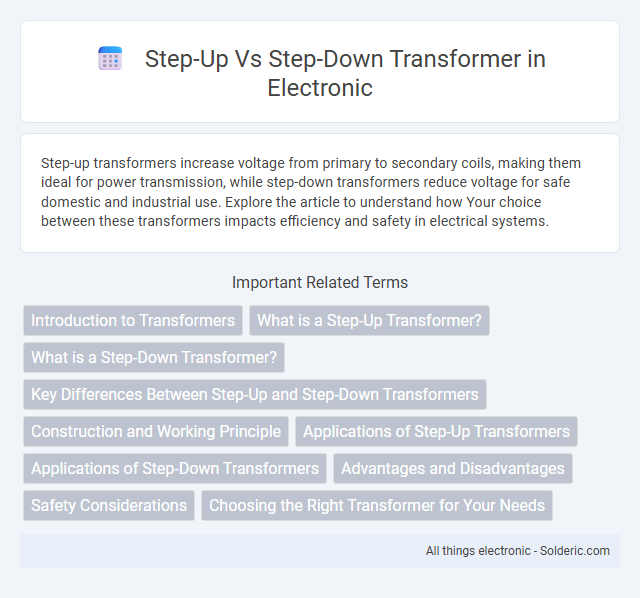Step-up transformers increase voltage from primary to secondary coils, making them ideal for power transmission, while step-down transformers reduce voltage for safe domestic and industrial use. Explore the article to understand how Your choice between these transformers impacts efficiency and safety in electrical systems.
Comparison Table
| Feature | Step-Up Transformer | Step-Down Transformer |
|---|---|---|
| Primary Function | Increases voltage from primary to secondary winding | Decreases voltage from primary to secondary winding |
| Voltage Ratio | Secondary voltage > Primary voltage | Secondary voltage < Primary voltage |
| Turns Ratio | Secondary turns > Primary turns | Secondary turns < Primary turns |
| Current Behavior | Secondary current < Primary current | Secondary current > Primary current |
| Typical Applications | Power transmission, voltage boosting for devices | Power supply adapters, voltage reduction for equipment |
| Efficiency | High, typically 95% or more | High, typically 95% or more |
| Example | Voltage step-up from 120V to 240V | Voltage step-down from 240V to 120V |
Introduction to Transformers
Transformers are electrical devices that modify voltage levels to facilitate power transmission and distribution efficiently. A Step-Up Transformer increases voltage from primary to secondary coils, ideal for long-distance electricity transfer, while a Step-Down Transformer decreases voltage to safer levels for household and industrial use. Understanding your specific voltage requirements ensures the correct transformer enhances energy efficiency and equipment safety.
What is a Step-Up Transformer?
A step-up transformer increases the voltage from the primary coil to the secondary coil while decreasing the current proportionally, enabling efficient long-distance electrical power transmission. It consists of more turns of wire on the secondary coil than on the primary coil, resulting in a higher output voltage. These transformers are commonly used in power plants to elevate voltage levels for reduced energy loss during transmission.
What is a Step-Down Transformer?
A Step-Down Transformer reduces high voltage to a lower voltage, making electricity safe and usable for household appliances and electronic devices. It consists of primary and secondary coils with fewer turns in the secondary coil to decrease voltage while maintaining power levels. These transformers are essential in electrical distribution systems to convert transmission voltages to safer, more practical levels for consumer use.
Key Differences Between Step-Up and Step-Down Transformers
Step-up transformers increase voltage from primary to secondary winding, enabling efficient long-distance power transmission. Step-down transformers reduce voltage from primary to secondary winding, making electrical energy safer and usable for household and industrial devices. The key difference lies in the turns ratio: step-up transformers have more turns on the secondary coil, while step-down transformers have fewer turns on the secondary coil compared to the primary.
Construction and Working Principle
Step-up and step-down transformers both consist of primary and secondary coils wound around a magnetic core, with the coil turn ratio determining voltage transformation. In a step-up transformer, the secondary coil has more turns than the primary, increasing voltage but decreasing current, while in a step-down transformer, the primary coil has more turns, reducing voltage and increasing current. Your understanding of Faraday's law of electromagnetic induction is key to grasping how alternating current in the primary coil generates a magnetic flux that induces voltage in the secondary coil, facilitating the voltage change.
Applications of Step-Up Transformers
Step-up transformers are widely used in power transmission to increase voltage levels, minimizing energy losses over long distances by transmitting electricity at high voltages and low currents. They are essential in electrical substations for boosting voltage from power plants before distribution across grids, enabling efficient and safe electricity delivery. Industrial applications also benefit from step-up transformers to supply high-voltage equipment and processes, such as in manufacturing and heavy machinery operations.
Applications of Step-Down Transformers
Step-down transformers are widely used in electrical power distribution systems to reduce high transmission voltages to lower levels suitable for residential and commercial use, typically stepping down from thousands of volts to standard utilization voltages like 120V or 240V. These transformers are essential in household appliances, industrial machinery, and electronic devices, ensuring safe and efficient operation by providing appropriate voltage levels. Furthermore, step-down transformers are employed in medical equipment, elevator systems, and lighting circuits where precise voltage control is critical for performance and safety.
Advantages and Disadvantages
Step-up transformers increase voltage from primary to secondary winding, enhancing transmission efficiency by reducing current loss but are less suitable for low voltage applications due to insulation requirements. Step-down transformers reduce voltage, ensuring safety and compatibility with household devices, yet they can experience increased current that may cause overheating without proper design. Understanding your power needs helps determine the appropriate transformer type, balancing efficiency and safety for your electrical system.
Safety Considerations
Step-up transformers increase voltage while lowering current, which requires careful insulation and protection to prevent electric shock and equipment damage, whereas step-down transformers reduce voltage to safer, usable levels for household or industrial devices, minimizing risk. You should ensure proper grounding and overload protection for both types to avoid overheating and electrical faults. Regular maintenance and adherence to safety standards are essential for preventing transformer failures and ensuring safe operation.
Choosing the Right Transformer for Your Needs
Selecting the right transformer depends on your voltage conversion requirements: step-up transformers increase voltage from primary to secondary, ideal for devices needing higher voltage input, while step-down transformers decrease voltage for safer, lower voltage applications. Understanding your equipment's voltage specifications and power ratings ensures compatibility and efficiency. Proper transformer choice safeguards your devices, optimizes performance, and enhances electrical safety in your setup.
Step-Up vs Step-Down Transformer Infographic

 solderic.com
solderic.com